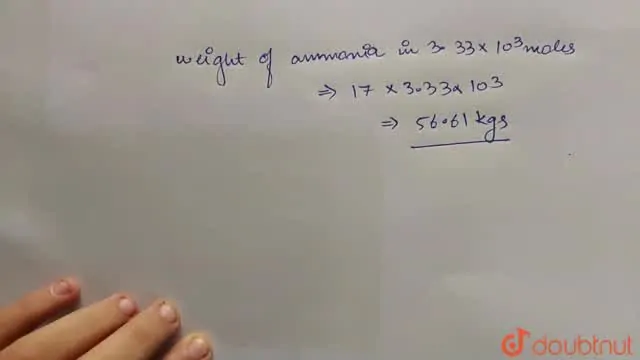50.0kg of N2(g) and 10kg of H2(g) are mixed to produce NH3(g). Calculate the NH3(g) formed. Identify the limiting reagent.
A balanced equation for the above reaction is written as follows :
N2 (g) 3H2(g)⇔2NH3(g)
Calculation of moles :
Number of moles of N2
=50.0kgN2×1000gN21kgN2×1molM22.016gH2
=4.96×103 mol
According to the above equation, 1 mol N2 (g) requires 3 molH2 (g), for the reaction. Hence, for 17.86×102 mol ofN2, the moles of H2 (g) required would be
=17.86×103MolN2×3molH2(g)1molN2(g)
=5.36×103 mol H2
But we have only 4.96×103mol H2. Hence, dihydrogen is the limiting reagent in this case. So, NH3(g) would be formed only from that amount of available dihydrogen i.e.,4.96×103mol
Since 3 mol H2(g) gives 2 mol NH3(g)
4.96×103molH2(g)×2molNH3(g)3molH2(g)
=3.30×103mol NH3 (g) is obtained .
If they are to be converted to grams, it is done as follows :
1 mol NH3(g)=17.0gNH3(g)
3.30×103 mol NH3(g)×17.0gNH3(g)1molNH3(g)
=3.30×103×17gNH3(g)
=56.1×103gNH3
=56.1kgNH3
Related Playlists
Similar Questions
One mole of N2 (g) is mixed with 2 moles of H2(g) in a 4 litre vessel If 50% of N2(g) is converted to NH3(g) by the following reaction :
N2(g)+3H2(g)⇔2NH3(g)
What will the value of Kc for the following equilibrium ?
NH3(g)⇔12N2(g)+32H2(g)View SolutionTaking one mole of N2(g) and excess of H2(g), under suitable conditions, formation of NH3 is completed when NH3(g) has mole fraction of 0.5, The initial moles of H2 are?
View Solution28 g of N2 and 6 g of H2 were mixed. At equilibrium 17 g NH3 was produced. The weight of N2 and H2 at equilibrium are respectively
View SolutionWhat volume of H2(g) is produced by decomposition of 2.4LNH3(g) ? .
View Solution40% of a mixture of 0.2 mol of N2 and 0.6 mol of H2 reacts to give NH3 according to the equation:
N2(g)+3H2(g)⇔2NH3(g)
at constant temperature and pressure. Then the ratio of the final volume to the initial volume of gases areView SolutionWhat volume of H2 at NTP is required to convert 2.8 g of N2 into NH3?
View SolutionApply law of mass action to the process,
N2(g)+3H2(g)⇔2NH3(g).View SolutionFor a reaction, N2(g)+3H2(g)→2NH3(g), identify dihydrogen (H2) as a limiting reagent in the following reaction mixtures.
View SolutionFor a reaction, N2(g)+3H2(g)→2NH3(g), identify dihydrogen (H2) as a limiting reagent in the following reaction mixtures.
View SolutionOne "mole" of NH4HS(s) was allowed to decompose in a 1−L container at 200∘C. It decomposes reversibly to NH3(g) and H2S(g).NH3(g) further undergoes decomposition to form N2(g) and H2(g). Finally, when equilibrium was set up, the ratio between the number of moles of NH3(g) and H2(g) was found to be 3.
NH4HS(s)⇔NH3(g)+H2S(g),Kc=8.91×10−2M2
2NH3(g)⇔N2(g)+3H2(g),Kc=3×10−4M2
Answer the following:
To attain equilibrium, how much % by weight of folid NH4HS got dissociated?View Solution


